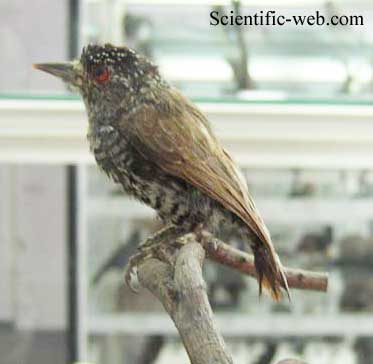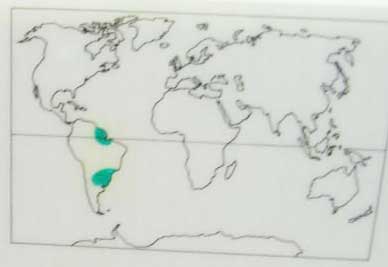
Picumnus cirratus, Photo: Michael Lahanas
Superregnum: Eukaryota
Cladus: Unikonta
Cladus: Opisthokonta
Cladus: Holozoa
Regnum: Animalia
Subregnum: Eumetazoa
Cladus: Bilateria
Cladus: Nephrozoa
Superphylum: Deuterostomia
Phylum: Chordata
Subphylum: Vertebrata
Infraphylum: Gnathostomata
Megaclassis: Osteichthyes
Cladus: Sarcopterygii
Cladus: Rhipidistia
Cladus: Tetrapodomorpha
Cladus: Eotetrapodiformes
Cladus: Elpistostegalia
Superclassis: Tetrapoda
Cladus: Reptiliomorpha
Cladus: Amniota
Classis: Reptilia
Cladus: Eureptilia
Cladus: Romeriida
Subclassis: Diapsida
Cladus: Sauria
Infraclassis: Archosauromorpha
Cladus: Crurotarsi
Divisio: Archosauria
Cladus: Avemetatarsalia
Cladus: Ornithodira
Subtaxon: Dinosauromorpha
Cladus: Dinosauriformes
Cladus: Dracohors
Cladus: Dinosauria
Cladus: Saurischia
Cladus: Eusaurischia
Subordo: Theropoda
Cladus: Neotheropoda
Cladus: Averostra
Cladus: Tetanurae
Cladus: Avetheropoda
Cladus: Coelurosauria
Cladus: Tyrannoraptora
Cladus: Maniraptoromorpha
Cladus: Maniraptoriformes
Cladus: Maniraptora
Cladus: Pennaraptora
Cladus: Paraves
Cladus: Eumaniraptora
Cladus: Avialae
Infraclassis: Aves
Cladus: Avebrevicauda
Cladus: Pygostylia
Cladus: Ornithothoraces
Cladus: Ornithuromorpha
Cladus: Carinatae
Parvclassis: Neornithes
Cohors: Neognathae
Cladus: Neoaves
Ordo: Piciformes
Familia: Picidae
Subfamilia: Picumninae
Genus: Picumnus
Species: Picumnus cirratus
Subspecies: P. c. cirratus – P. c. confusus – P. c. macconnelli – P. c. pilcomayensis – P. c. thamnophiloides – P. c. tucumanus
Name
Picumnus cirratus Temminck, 1825
References
Nouveau recueil de planches coloriées d'oiseaux livr.62 pl.371 fig.1
Vernacular names
English: White-barred Piculet
español: Carpinterito Común
suomi: Liaanitikkanen
français: Picumne frangé

The white-barred piculet (Picumnus cirratus) is a species of bird in the woodpecker family Picidae.[2] It is found in Argentina, Bolivia, Brazil, French Guiana, Guyana, Paraguay, and Uruguay.[3]
Taxonomy and systematics
The white-barred piculet was first described in 1825 by the Dutch zoologist Coenraad Jacob Temminck. Six subspecies are recognized:[2]
P. c. macconnelli Sharpe, 1901
P. c. confusus Kinnear, 1927
P. c. cirratus Temminck, 1825
P. c. pilcomayensis Hargitt, 1891
P. c. tucumanus Hartert, E.J.O., 1909
P. c. thamnophiloides Bond, J. & Meyer de Schauensee, 1942
The white-barred piculet's taxonomy and that of genus Picumnus in general are uncertain. Molecular studies show that it is a sister species to the ochre-collared piculet (P. temminckii) and also closely related to the ocellated piculet (P. dorbignyanus), and at different times these species have been treated as synonymous. Subspecies pilcomayensis, thamnophiloides, and tucumanus intergrade in northern Argentina and are sometimes considered a separate species. Subspecies pilcomayensis and cirratus intergrade in eastern Paraguay. Subspecies confusus and macconnelli may also form a distinct species. The white-barred piculet also hybridizes widely with several other species of piculet where their ranges overlap; these include the varzea (P. varzeae) along the Amazon River, the ochre-collared in southeastern Brazil, and the ocellated and the white-wedged piculet (P. albosquamatus) in Bolivia.[4][5][6]
The specific epithet cirratus means "curly headed", cirrus being Latin for a ringlet or curl.[7]
Picumnus cirratus (male) in the Botanical Garden of Asunción, Paraguay
Description
The white-barred piculet is about 10 cm (3.9 in) long and weighs 6.3 to 12 g (0.22 to 0.42 oz). Adult males of the nominate subspecies P. c. cirratus have a black cap with a red patch on the forehead and white spots on the rest of it. Their face is mostly dark buff-brown with faint blackish bars and a white stripe behind the eye. Their upperparts are dull brownish, sometimes with faint darker bars. Their flight feathers are dark brown with buffish white edges on the secondaries and tertials. Their tail is dark brown; the innermost pair of feathers have mostly white inner webs and the outer two or three pairs have a white patch near the end. Their chin and throat feathers are white to pale buff with blackish bars. The rest of their underparts are white with black barring and a buff tinge to the belly and flanks. Their iris is dark chestnut-brown, the orbital ring blue-gray, the beak black with a pale base to the mandible, and the legs gray. Adult females are identical but with no red on the forehead. Juveniles are duller and darker than adults and have an unspotted crown, more obvious barring on their upperparts, and heavier barring on their underparts.[5][8]
Subspecies P. c. confusus has a darker face than the nominate with no white line behind the eye, brown upperparts, and a heavily barred throat. P. c. macconnelli is similar to confusus but without barring on its upperparts; its face sometimes has white spots and the throat and breast have heavier barring. P. c. thamnophiloides has grayish upperparts and fewer markings on the underparts except for "arrowheads" on the flanks. P. c. tucumanus has distinctly barred gray-brown upperparts, a buffier throat and breast with more obscure bars than the nominate, and less red to no red on the crown. P. c. pilcomayensis has grayish upperparts, narrow black and white barring on the underparts, and little to no red on the crown.[5]
Picumnus cirratus (female) in Asunción, Paraguay
Distribution and habitat
The white-barred piculet has two widely separated ranges. The subspecies are found thus:[2][5]
P. c. macconnelli, northeastern Brazil's eastern Amazon Basin west to the Rio Tapajós
P. c. confusus, southwestern Guyana, French Guiana, and Roraima state in extreme northern Brazil
P. c. cirratus, southeastern Brazil south from Minas Gerais and Espírito Santo to eastern Paraguay
P. c. pilcomayensis, from southeastern Bolivia and Paraguay into northeastern Argentina and also Uruguay[9][3]
P. c. tucumanus, northwestern Argentina
P. c. thamnophiloides, southeastern Bolivia to northwestern Argentina
The white-barred piculet inhabits a variety of landscapes including wet and dry woodland, forest edges, thickets, gallery forest in savannah, scrub, bamboo clumps, várzea, and overgrown parks and gardens. In elevation it ranges from near sea level to about 2,100 m (6,900 ft).[8][5]
Behavior
Movement
As far as is known the white-barred piculet is a year-round resident throughout its ranges.[5]
Feeding
The white-barred piculet usually forages singly, but may join small mixed species foraging flocks. It feeds on ants, insect larvae and eggs especially those of wood-boring beetles, and other small invertebrates. It actively drills holes in wood and may also feed on sap that oozes from puncture marks. It mostly feeds on twigs and branch tips but also vines and bamboo, sometimes clinging to the underside.[8][5]
Breeding
The white-barred piculet's northern subspecies breed between July and December and the southern ones between September and March. Both sexes excavate a nest hole, usually in a slender tree branch; the height above ground varies but can be as low as 2 m (7 ft). the clutch size is two to four eggs. Both sexes incubate but the incubation period and time to fledging are not known.[8][5]
Dickcissel male perched on a metal pole singing, with neck stretched and beak open.
Songs and calls
Listen to white-barred piculet on xeno-canto
Vocal and non-vocal sounds
The white-breasted piculet's primary vocalization is an "extr. high, dry, fast trill, like 'trrrrriut'."[10] It also makes a "tsirit, tsick" call, and its drumming on dead wood is "a loud staccato".[5]
Status
The IUCN has assessed the white-breasted piculet as being of Least Concern. It has an extremely large range, and though its population size is not known and thought to be decreasing, neither have reached the thresholds for a more critical rating. No immediate threats have been identified.[1] It appears to be fairly common to common in most of its range and occurs in several protected areas. However, it is "locally threatened by continuing deterioration of remnant forest habitat" in areas of urban growth.[5]
References
BirdLife International (2016). "White-barred Piculet Picumnus cirratus". IUCN Red List of Threatened Species. 2016: e.T22680739A92875519. doi:10.2305/IUCN.UK.2016-3.RLTS.T22680739A92875519.en. Retrieved 12 January 2023.
Gill, F.; Donsker, D.; Rasmussen, P., eds. (August 2022). "Woodpeckers". IOC World Bird List. v 12.2. Retrieved January 9, 2023.
Remsen, J. V., Jr., J. I. Areta, E. Bonaccorso, S. Claramunt, A. Jaramillo, D. F. Lane, J. F. Pacheco, M. B. Robbins, F. G. Stiles, and K. J. Zimmer. Version 24 July 2022. Species Lists of Birds for South American Countries and Territories. https://www.museum.lsu.edu/~Remsen/SACCCountryLists.htm retrieved July 24, 2022
Remsen, J. V., Jr., J. I. Areta, E. Bonaccorso, S. Claramunt, A. Jaramillo, D. F. Lane, J. F. Pacheco, M. B. Robbins, F. G. Stiles, and K. J. Zimmer. Version 24 July 2022. A classification of the bird species of South America. American Ornithological Society. https://www.museum.lsu.edu/~Remsen/SACCBaseline.htm retrieved July 24, 2022
Winkler, H., D. A. Christie, and G. M. Kirwan (2020). White-barred Piculet (Picumnus cirratus), version 1.0. In Birds of the World (J. del Hoyo, A. Elliott, J. Sargatal, D. A. Christie, and E. de Juana, Editors). Cornell Lab of Ornithology, Ithaca, NY, USA. https://doi.org/10.2173/bow.whbpic1.01 retrieved January 12, 2023
Eugene M. McCarthy (2006). Handbook of Avian Hybrids of the World. Oxford University Press, USA. p. 108. ISBN 978-0-19-518323-8.
Jobling, James A. (2010). Helm Dictionary of Scientific Bird Names. Bloomsbury Publishing. p. 109. ISBN 978-1-4081-3326-2.
Gorman, Gerard (2014). Woodpeckers of the World: A Photographic Guide. Firefly Books. pp. 65–67. ISBN 978-1770853096.
Claramunt, S.; Cuello, J. P. (2004). "Diversidad de la biota uruguaya. Aves" (PDF). Anales del Museo de Historia Natural y Antropología. 10 (6): 34.
van Perlo, Ber (2009). A Field Guide to the Birds of Brazil. New York: Oxford University Press. p. 192. ISBN 978-0-19-530155-7.
Retrieved from "http://en.wikipedia.org/"
All text is available under the terms of the GNU Free Documentation License

